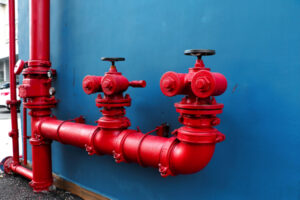
Today, we’ll go over the draining processes for both wet and dry fire sprinkler systems.
Commercial buildings of all kinds will need some sort of fire protection system in place. A commonly-used protection feature is fire sprinklers. These sprinklers are great to have in a pinch, as they can help you avoid harm to both people and your property. Eventually, these sprinklers will need to be drained, and the draining process will vary based on the type of sprinkler system you have. Today, we’ll go over the draining processes for both wet and dry fire sprinkler systems.
Wet Fire Sprinkler Systems
When you’re draining wet fire sprinkler systems, you want to start by closing all of the control valves for your sprinklers. The closed valves will need to get tagged as well. After that has been done, you should open both the auxiliary and main drain valves so that you can allow your system to properly drain. After all of the water has finished draining, close the valves back up.
You’ll want to see if you have any water stuck around the lower points of your piping that don’t have auxiliary drains. That piping should be removed in order to let the water drain, at which point, you should replace the piping. Once that’s finished, you should get rid of the water that’s from your valve pits. Finally, open all of the closed control valves that you tagged earlier.
Dry Fire Sprinkler Systems
To start the draining process for dry fire sprinkler systems, you should shut both valves around your auxiliary drains. Around the bottom valve, there should be a plug that you want to remove. Once it’s removed, put a container in that area so that you can collect all of the drained water. You should open your top valve at a gradual rate until you get it opened all the way, at which point, you should allow all of the water to get drained out. Once draining is completed, you should shut the bottom valve. This process might need to be repeated multiple times until you stop seeing water getting drained. When there’s no more water left to drain, close your bottom valve, open up the top valve slowly, then get the plug replaced
KEEP YOURSELF SAFE WITH ANDERSON FIRE PROTECTION, INC.
Anderson Fire Protection, Inc. has the expertise and skill to help your home or commercial property for all your fire protection needs. We have been working in the Maryland, Northern Virginia, Southern Pennsylvania, and Washington, D.C. areas for over 25 years. We are known for our top-notch customer service and high-quality results. If you are ready for fantastic fire prevention and protection services, from fire sprinkler installation to fire alarm design and to consult, give us a call at (410) 796-4915 or visit us online.
